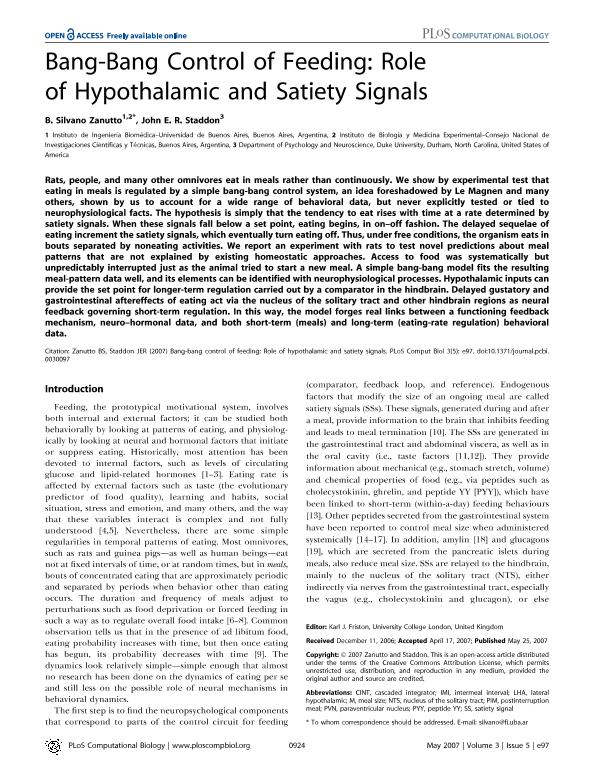Mostrar el registro sencillo del ítem
dc.contributor.author
Zanutto, Bonifacio Silvano

dc.contributor.author
Staddon, John E.
dc.date.available
2017-10-10T15:23:24Z
dc.date.issued
2007
dc.identifier.citation
Zanutto, Bonifacio Silvano; Staddon, John E.; Bang-bang control of feeding: role of hypothalamic and satiety signals; Public Library of Science; Plos Computational Biology; 3; 5; -1-2007; 924-931
dc.identifier.issn
1553-7374
dc.identifier.uri
http://hdl.handle.net/11336/26333
dc.description.abstract
Rats, people, and many other omnivores eat in meals rather than continuously. We show by experimental test that eating in meals is regulated by a simple bang-bang control system, an idea foreshadowed by Le Magnen and many others, shown by us to account for a wide range of behavioral data, but never explicitly tested or tied to neurophysiological facts. The hypothesis is simply that the tendency to eat rises with time at a rate determined by satiety signals. When these signals fall below a set point, eating begins, in on–off fashion. The delayed sequelae of eating increment the satiety signals, which eventually turn eating off. Thus, under free conditions, the organism eats in bouts separated by noneating activities. We report an experiment with rats to test novel predictions about meal patterns that are not explained by existing homeostatic approaches. Access to food was systematically but unpredictably interrupted just as the animal tried to start a new meal. A simple bang-bang model fits the resulting meal-pattern data well, and its elements can be identified with neurophysiological processes. Hypothalamic inputs can provide the set point for longer-term regulation carried out by a comparator in the hindbrain. Delayed gustatory and gastrointestinal aftereffects of eating act via the nucleus of the solitary tract and other hindbrain regions as neural feedback governing short-term regulation. In this way, the model forges real links between a functioning feedback mechanism, neuro–hormonal data, and both short-term (meals) and long-term (eating-rate regulation) behavioral data.
dc.format
application/pdf
dc.language.iso
eng
dc.publisher
Public Library of Science

dc.rights
info:eu-repo/semantics/openAccess
dc.rights.uri
https://creativecommons.org/licenses/by-nc-sa/2.5/ar/
dc.subject
Satiety Signal
dc.subject
Hypothalamic Signal
dc.subject
Nuecleus Tractus Solitarius
dc.subject
Feeding Longterm Regulation
dc.subject.classification
Neurociencias

dc.subject.classification
Medicina Básica

dc.subject.classification
CIENCIAS MÉDICAS Y DE LA SALUD

dc.title
Bang-bang control of feeding: role of hypothalamic and satiety signals
dc.type
info:eu-repo/semantics/article
dc.type
info:ar-repo/semantics/artículo
dc.type
info:eu-repo/semantics/publishedVersion
dc.date.updated
2017-10-06T18:01:04Z
dc.identifier.eissn
1553-7358
dc.journal.volume
3
dc.journal.number
5
dc.journal.pagination
924-931
dc.journal.pais
Estados Unidos

dc.journal.ciudad
San Francisco
dc.description.fil
Fil: Zanutto, Bonifacio Silvano. Consejo Nacional de Investigaciones Científicas y Técnicas. Instituto de Biología y Medicina Experimental. Fundación de Instituto de Biología y Medicina Experimental. Instituto de Biología y Medicina Experimental; Argentina. Universidad de Buenos Aires. Facultad de Ingenieria. Instituto de Ingeniería Biomédica; Argentina
dc.description.fil
Fil: Staddon, John E.. University of Duke; Estados Unidos
dc.journal.title
Plos Computational Biology

dc.relation.alternativeid
info:eu-repo/semantics/altIdentifier/url/http://journals.plos.org/ploscompbiol/article?id=10.1371/journal.pcbi.0030097
dc.relation.alternativeid
info:eu-repo/semantics/altIdentifier/doi/http://dx.doi.org/10.1371/journal.pcbi.0030097
dc.relation.alternativeid
info:eu-repo/semantics/altIdentifier/url/https://www.ncbi.nlm.nih.gov/pmc/articles/PMC1876490/
dc.relation.alternativeid
info:eu-repo/semantics/altIdentifier/pmid/17530919
Archivos asociados
